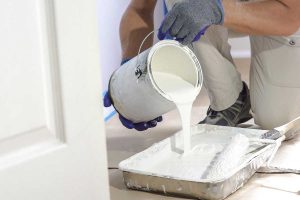You may probably already know how a few coats of paint can easily transform a room. But if the paint finish you’re working with doesn’t fit into the style you’re aiming for, the cohesivity of your aesthetic can be affected.
Semi-gloss paint is often used in interiors because of its durability and stain resistance. But if its sheen looks too overwhelming for your taste, a satin finish may be more suitable for your home.
But considering the texture and sheen of semi-gloss paint, can you easily layer a satin finish over it? To help prevent you from making a big painting mistake below is a quick guide for covering a semi-gloss paint with satin.
What is semi-gloss paint?
True to its name, semi-gloss paint has a lesser sheen compared to high-gloss and gloss finishes. It can last longer than flat or matte finishes because you can easily wipe off any stains with a damp cloth. That’s why it’s often recommended for rooms with high traffic, like kitchens, playrooms, or family rooms.
Semi-gloss paint can also be used for painting bathrooms or laundry room walls since its high-polyurethane content creates a protective layer to prevent mold and mildew from growing. You can also apply it on doors, trims, or window frames to create a contrast and make them stand out.
What is satin paint?
If the reflectivity of semi-gloss paint is too much for your preference, you might like a satin finish better. An untrained eye may sometimes mistake a satin finish for a semi-gloss paint, but if you look closer you’ll notice there’s a subtle difference between their sheen.
Although both paints are durable and water-resistant, satin paint is more forgiving when it comes to covering up dings, blemishes, and dents on the wall. Since it’s not as reflective as a semi-gloss finish, wall imperfections won’t be as noticeable.
Because of its soft and velvety appearance, satin paint is ideal for subduing brightly lit rooms since light won’t bounce off its surface as much. You can do this by painting large window frames with satin paint to lessen the glare of light that enters the room.
What happens if you paint over semi-gloss with satin?
If you’ve decided that semi-gloss paint isn’t the best option for your room, it’s possible to paint it over with a satin finish. But it’s not recommended that you layer it directly because the new paint will have trouble adhering to the surface due to the sheen and smooth texture of semi-gloss paint.
To remedy this, you’ll have to sand the walls you want to paint to create texture where the satin paint can stick to. You’ll then have to apply a compatible primer to cover up the reflective sheen of the old semi-gloss paint.
This method is also recommended for when you want to apply latex satin paint over an oil-based semi-gloss or vice versa. Since latex and oil-based paint don’t cure well together, skipping these steps will give you a thick coat that easily peels off.
How do I paint over a semi-gloss finish?
As discussed above, painting over a semi-gloss finish will require a bit of preparation. To guide you on how to layer it over with satin paint, follow the steps below:
1. With a damp cloth, wipe the wall to remove any dust or stains and let it dry completely before you proceed to the next step.
2. Once it’s dry, apply a spackling compound on any holes or cracks on the wall and let it dry.
3. You can then start sanding the wall with 150-grit sandpaper in one direction until the sheen of the semi-gloss paint is gone. Remember to vacuum or sweep away any dust once you’re done to keep your area clean and safe. Wipe the wall again with a damp cloth to remove any dust and allow it to dry.
4. Since it’s always recommended to prime a wall when painting, apply a layer of primer that’s compatible with your satin paint.
5. Once the primer is completely dry, you can finally apply 1-2 coats of satin paint – making sure it’s completely dry between each coat.
Can you paint satin over semi-gloss without sanding?
Whether you’re short on time or the previous semi-gloss paint is lead-based, sanding the walls may not be an option. Since sanding lead-based paint creates harmful lead dust, your next best option is to prep the wall with an ammonia and warm water solution to soften it.
To do this, mix ½ cup of ammonia with 1 gallon of warm water and use a cloth to wipe it on the walls. Once you’ve removed any stains or grease, use another clean damp cloth to wipe the solution away.
To make this process effective, you’ll need to determine whether the semi-gloss paint is latex or oil-based since you’ll need to apply the same base for the satin paint. If you’re not sure, you can rub a damp cotton ball on a spot on the wall. If it comes out with some color, the semi-gloss paint is latex water-based, if not you’ll know it’s oil-based.
Next, use a stiff-bristled brush to roughen up the surface of the paint. This will help the satin paint adhere better to the walls so it has a longer lifespan.
Once you’re done, you can finally apply 1-2 coats of your satin paint, but remember to allow the paint dry completely between each coat. You can also touch up certain areas where the paint appears uneven or streaky.
Need help with painting your home?
If you’re still struggling with painting over a semi-gloss finish, it might be the right time to call in the professionals. Soho Painters has a team of experienced painters that can easily cover up any paint finish with guaranteed flawless results. Whether you need help with painting the exterior or interior of your home, you can rest assured your project will be in the right hands. For inquiries, you can contact their team now to get a free estimate.





